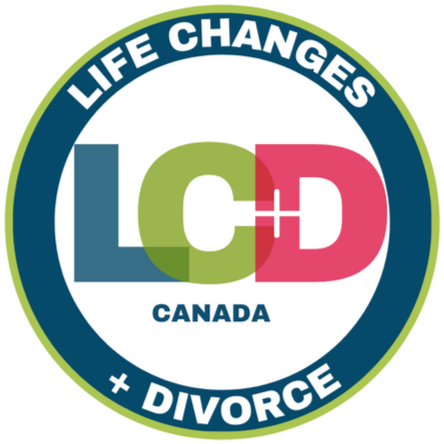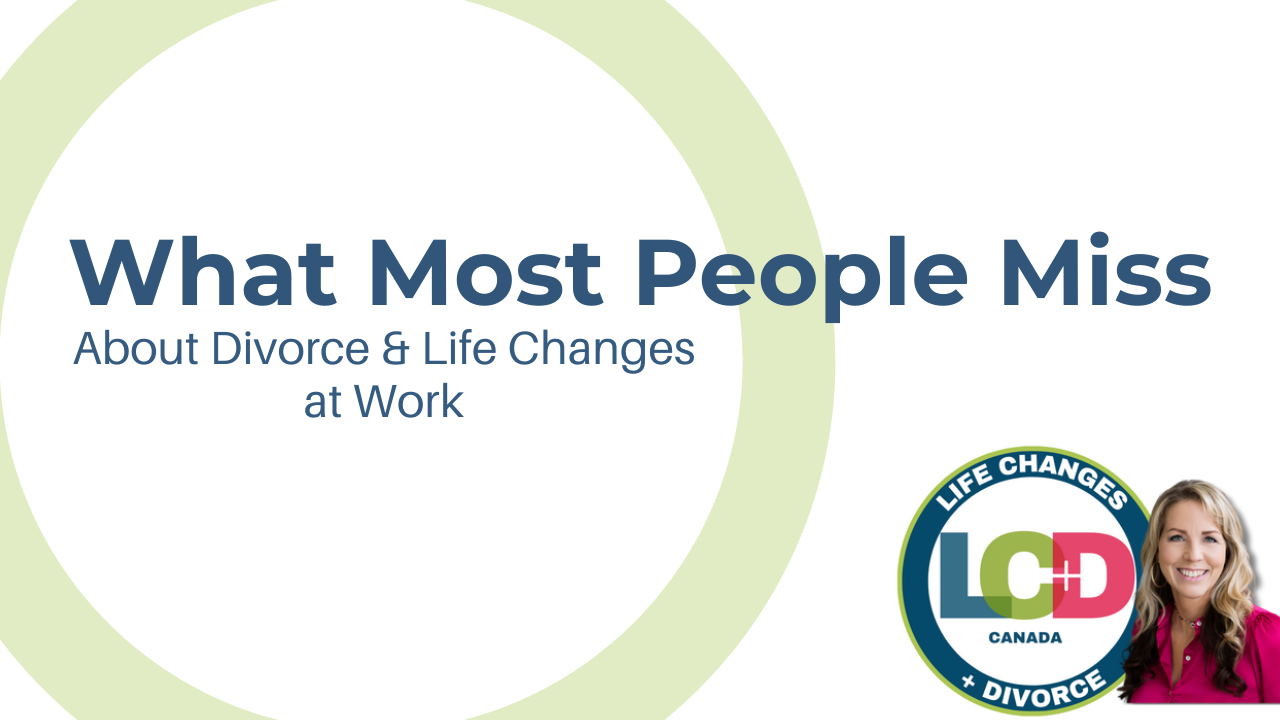What Most People Miss About Divorce & Life Changes at Work
What if the thing disrupting your team’s performance… isn’t about deadlines, skills, or even leadership?
What if it’s something far more personal, but almost entirely invisible at work?
The Unspoken Reality of Workplaces
Divorce. Domestic abuse. Major life transitions.
These aren’t just personal issues, they’re work issues. And yet, most organizations treat them like off-the-clock problems.
Even in a world that claims to be more “human-centric,” there’s a limit to how much humanity we’re comfortable addressing in the workplace.
As someone who spent more than 30 years surviving domestic abuse, while also showing up professionally, I know firsthand how deeply life outside of work affects performance inside it. I also know what it feels like to suffer in silence.
I don’t want anyone else to feel that way.
Where Life Meets Work
Let’s start with the basics.
Where do people spend most of their waking hours? At work. So when life unravels, whether through divorce, trauma, loss, grief, or caregiving responsibilities, it doesn’t pause for 9-to-5. It seeps into everything.
You might see it in:
Missed deadlines
Withdrawn behavior
Presenteeism (physically present, emotionally absent)
Sudden absences or turnover
But often, you won’t see it at all.
Because we’ve conditioned people to leave their struggles at the door, and in doing so, we’ve made workplaces less safe and far less supportive during the moments people need it most.
What Most People Think the Problem Is
Many leaders assume the issue is just discomfort:
“We don’t talk about divorce or abuse at work.” “That’s a private matter.” “We have EAPs for that.”
Or worse, they think if someone really needs help, they’ll ask for it.
But here’s the truth: they don’t. Because asking feels risky. Because it’s vulnerable. Because they’re not sure what the response will be.
Most workplaces have no visible roadmap for how to respond to these deeply human challenges. So employees retreat further into silence, while performance suffers in ways leadership often misreads.
What’s Really Happening Behind the Scenes
Let’s look at the numbers.
Nearly 50% of Canadian marriages end in divorce
1 in 3 women and 1 in 4 men experience intimate partner violence
Red Deer, Alberta, has the highest per-capita domestic abuse rate in the country
Workplace losses from life transitions like divorce and abuse cost Canadian companies over $1.5 billion annually
And yet, Employee Assistance Programs (EAPs), the most common solution, have a 5% usage rate. They’re underutilized, often generic, and not often trauma-informed.
Meanwhile, HR leaders and managers are left without a clear path forward. They notice something is off, but fear crossing a line. They don’t want to make things worse. So they do… nothing.
And employees? They suffer in silence, while companies quietly bleed productivity and morale.
A Real-Life Example: What It Feels Like
During my own divorce and exit from abuse, I showed up to work every day.
On the outside, I looked fine. I got my tasks done. But inside? I was navigating fear, exhaustion, and isolation.
I didn’t know who I could trust. I didn’t feel safe sharing my reality with anyone at work. So I put on a mask, and paid the price with my energy, engagement, and emotional bandwidth.
And I wasn’t alone.
The more I’ve built community through LifeChangesMag.com through our podcast, magazine, and events, the more stories I’ve heard from people in similar situations. People who were managing divorce, legal stress, abuse, grief, or sudden transitions, while quietly trying to “keep it together” at work.
Why This Problem Is So Often Missed
There are a few key reasons:
Cultural avoidance We’ve built workplaces that talk about wellness and empathy, but only within certain limits. We praise resilience, not rawness. We support “mental health” in theory, but get uncomfortable when someone actually breaks down in front of us.
Policy limitations HR teams often don’t have training or protocols for handling deeply personal crises. The fear of legal risk or crossing personal boundaries can create a chilling effect, even when the intent is to help.
Lack of visibility Divorce and abuse don’t show up in metrics. They don’t get disclosed on performance reviews. Without systems to ask the right questions or signal safety, these issues remain hidden, until they impact retention, morale, or performance.
The True Cost of Ignoring This
Let’s make it plain: the cost isn’t just emotional. It’s operational.
Absenteeism and presenteeism rise
Turnover increases, especially among top performers who don’t feel supported
Retention drops, and the cost of re-hiring and retraining grows
Company culture suffers, as empathy becomes performative instead of practiced
More importantly, you miss the chance to be the kind of workplace people talk about with gratitude.
The kind that supported them during their hardest season, not just their most productive one.
What a Better Approach Looks Like
At LifeChangesMag.com, we’ve built a resource ecosystem that bridges the gap between personal upheaval and professional support. Here’s what works:
Dedicated Dialogue We help companies facilitate honest, informed conversations, without fear or judgment. Resources for HR and leadership that go beyond “just listen.”
Expert Connections Divorce coaches. Abuse counselors. Legal and financial professionals. Our network connects employees to the right help at the right time.
Safe, Digital Communities Ongoing support through private forums, podcasts, webinars, and interactive content, so no one feels alone in their journey.
This isn’t a “one-size-fits-all” wellness initiative. It’s a strategic shift toward actual human support, done with curiosity and compassion.
The Reframe Leaders Need
Instead of asking:
“Is this appropriate to talk about at work?”
Ask:
“How can we create space for life to show up, and respond with care, not control?”
You don’t need to be a therapist. You just need to be a human leader. One who’s curious, not invasive. Compassionate, not performative.
That means:
Checking in without prying
Offering resources without pressure
Understanding “vulnerability hangovers”, the emotional recoil after someone opens up, and creating psychological safety on the other side of it
What Employees Actually Want
We’ve seen it over and over again in our community of 30,000+ Canadians:
Employees want:
A sense of being seen and valued beyond their productivity
Accessible, relevant resources that fit their situation
Permission to ask for help without shame
And employers want:
Retention and engagement
Reduced absenteeism and distraction
A culture where people don’t just stay, they thrive
These aren’t competing interests. But they require new tools, new language, and new partnerships to make happen.
A Note for HR Leaders and Decision-Makers
If you’re in HR, you’ve probably felt the tension:
You want to do the right thing, but you're worried about crossing boundaries
You want to offer support, but aren’t sure what resources are “safe” or relevant
You rely on EAPs, but see how little they’re used
We’re here to help you bridge that gap, without blowing up your budget or compliance protocols.
Our solutions are cost-effective and designed to augment, not replace, what you already offer.
We’re already working with forward-thinking partners like:
Sagesse
Sendero Centre
Red Deer Polytechnic
Scotia Wealth
Empowered Collaboration
Let’s build something together that leaves people better off, personally and professionally.
Summary: What Most People Miss
We often think supporting employees is about perks and programs.
But what most people miss is this: Support is most powerful when it shows up during the hardest moments, not just the strategic ones.
If your workplace truly wants to be human-first, start where humanity hurts and build systems that hold people when life gets messy.
That’s what changes culture. That’s what builds loyalty. That’s what makes people say: “I was supported here when life was hard and I’ll never forget it.”
Two Ways to Go Deeper
If this resonates, here’s what you can do next:
Comment below: Share how your organization has supported (or missed) a major life transition for employees.
Visit LifeChangesMag.com to explore tools, community and resources for navigating divorce, abuse and transitions, at work and beyond.
Remember! Things are not always as they appear & everyone has a story. See the Human First :)
~ Your Curious Friend, Deena
This article was written by Deena Kordt and featured in her ‘Human First’ LinkedIn Newsletter.
📖 You can subscribe here.
Meet the Author - Deena Kordt
Deena Kordt, publisher of Life Changes & Divorce Magazine Canada, host of the Life Changes Channel podcast, is also an author & speaker from Southern Saskatchewan with a passion for inspiring personal growth and community support. Growing up on a farm and ranch, she developed strong small-town values and a deep sense of community. Deena has had a diverse career, including roles as a nurse, librarian, and reiki master, but her most cherished role is as a mother.
Deena's books, podcast, magazines, blog and presentations aim to help individuals reconnect with their inner strength and joy, encouraging them to embrace life with courage and resilience. She has overcome significant personal challenges, including the loss of two brothers and living in an abusive situation, which has fueled her mission to support others on their healing journeys.
Known for her adventurous spirit and rock 'n roll heart, Deena believes in the power of a supportive community of women. She invites you to join her in exploring life with curiosity and courage.
Awards and Recognition:
2023 Womanition Trail Blazer Award Nominee
2024 Soroptimist International Ruby Award Winner
2025 IOFP Top Women’s Leadership Coach & Publisher of the Year
Deena has been featured on several podcasts and magazines, co-hosts the “Shift Happens Show” and is working on her memoir.
Note: The author, compiler and publisher do not assume and hereby disclaim any liability to any party due to these words coming from the author’s own opinion based on their experiences. This account is based on the author’s own personal experience. We assume no responsibility for errors or omissions in these articles.


